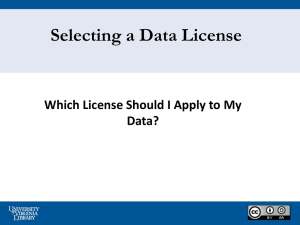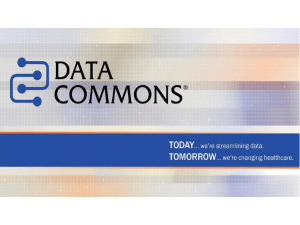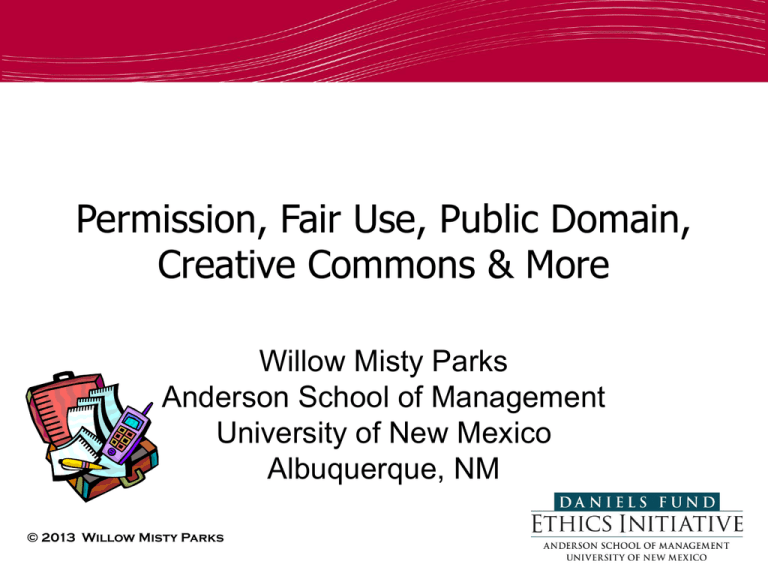
Permission, Fair Use, Public Domain,
Creative Commons & More
Willow Misty Parks
Anderson School of Management
University of New Mexico
Albuquerque, NM
© 2013 Willow Misty Parks
IMPORTANT NOTICE
• General legal information.
• This presentation is NOT legal advice
or legal representation.
• This presentation sets out general
concepts.
• Anyone determining that they need
legal advice or representation should
seek counsel and advice from an
attorney or law firm.
Topics
I.
II.
III.
IV.
V.
Getting Permission
Fair Use
Public Domain
Creative Commons/ Attribution
Other options
I. GNU
II. Wikipedia licenses
III. General permission granted
VI. Types of Works
VII. Other Considerations
Introduction
Why does permission matter?
“It isn't what we don't know that gives us trouble,
it's what we know that ain't so.”
—Will Rogers
I.
People believe that if they change a work enough or
use it in a collage, it is not infringement. *
II. Many people do not understand the extent of
ownership and are later limited in the uses for their
work due to infringement.
III. There are many myths around copyright that are not
true.
IV. If people understood intellectual property rules at the
start, they could find works that are in public domain
and available in fair use.
Is Permission Required?
• Determine if the selected material requires
permission from the copyright holder or if it
is fair use.
• Review fair use factors and be cautious if
portrays copyright holder in a negative
light.
• Proper credit should always be given to
the original source.
Getting Permission
• Is permission required?
• Getting permission is a process of getting
consent from the owner of the intellectual
property or creative work.
• Permission is sometimes called “licensing.”
• Permission means you have a license to use
the work.
• Use without permission is violating or
infringing the owners’ rights.
Getting Permission
• Unauthorized use, intentionally or out of
ignorance, may lead to legal consequences:
lawsuit, forced to stop using, and/or pay money
to the owner.
• Ethics question of using someone's intellectual
property without permission.
• The more successful a project may become, the
more likely the infringement will be detected and
enforced.
• Fear costs of paying for permission.
Getting Permission
Steps:
•
•
•
•
Is permission needed?
Identify owner
Identify uses and rights required
Contact owner or Licensing org.
– iCopyright or CCC (Copyright Clearance Center)
• Determine request process and costs for
permission.
• Get agreement in writing!
Exceptions to Permission
• In most cases permission is required!
• Exceptions
– “Fair Use”
– Public Domain works
– Works dedicated by the author for public use.
– Terms of use: check if permission/license has
limitations or requirements such as limited to
non-commercial, use in its full form, and/or
including authors’ information and biography.
Fair Use
• Uses
• Factors
• Other considerations such as “shrink
wrap” contracts that can limit fair use by
contract.
Is It Fair Use or Infringement?
First, consider purpose: criticism, comment, news reporting,
teaching, scholarship, or research and parody
Four factors to be considered:
1.
2.
3.
4.
Purpose and character of the use, including whether it is
commercial nature or for nonprofit educational purpose
The nature or the copyrighted work (creative, fact, useful,
compilation)
The amount and substantiality of the portion used in relation to the
whole (a short quote or an entire article, the heart Y of the work)
The effect of the use upon the potential market for or value of the
copyrighted work.
Beware! No reliable general quantitative standards. If you are relying on
fair use to use someone else’s copyrighted work, be very, very
careful. Ultimately, only a judge or jury has the final say on whether
your use is “fair use” or not.
Erasing the Blanket Educational
& Nonprofit Myth
• There is NO blanket educational or non-profit exception to the
copyright.
• Movies played in class:
Performance or display of a legal copy of a work by instructors or
pupils in the course of face-to-face teaching activities or a
nonprofit educational institution, in a classroom or similar place
devoted to instructional use is not a copyright infringement.
• Textbooks: copies pose significant risks
• Course packets: have been heavily litigated
• Guidelines for Copies of Books or Periodicals for Classroom
Purposes by Not-For-Profit Educational Institutions: 1. Brevity, 2.
Spontaneity, 3. Cumulative effect, and 4. A notice of copyright.
Parody & Fair Use
•
•
•
•
•
Practically by definition, you will NOT be able to obtain the author’s
permission for this use. Indeed, the owner of a work seldom wants to
license someone else to ridicule that work.
“Fair use” is the guarantee of breathing space within the confines of
copyright.
Parody: A literary or artistic work that imitates the characteristic style of
an author or a work for comic effect or ridicule—burlesque, satire,
criticism, raunchy twist, and spoof.
Parody’s humor, its comment, necessarily springs from recognizable
allusion to its object through distorted imitation. Its art lies in the
tension between a known original and its periodic twin.
Mostly, reflected in the application of Factor 3 of Fair Use; thus, allows
more of the original to be used.
Public Domain Sources:
What Works Are in Public Domain?
“Public Domain” are works that for one reason or another are not
covered by copyright and are ordinarily free for all to use.
• Works out of copyright: created before 1924 in the
United States
• Type of work not protected under copyright or
patent/trademark
• Work dedicated to public domain by owner
• Improperly registered or not renewed works created
before 1978
• If in a government publication be sure not from another
protected source
Public Domain
• No permission is required for works in
Public Domain.
• Important to acknowledge sources by
using credit line “Source” or “Data from”
• Examples: Hamlet, by William Shakespeare, Moby
Dick by Herman Melville, The 5th Symphony by Ludwig
van Beethoven (except for recordings), Little Women, by
Louisa May Alcott, Frankenstein by Mary Shelley, Pride
and Prejudice by Jane Austen, The Adventures of Tom
Sawyer by Mark Twain, etc.
Public Domain
• Expired Copyright
• Not properly renewed: between 1922 and before
1964 and not renewed in the 28th year.
• Dedicated works
• “Caution”: multilayered works, modified,
patented idea & trademark.
• If it’s in public domain, you may use it, but
academic honesty requires that you still attribute
to the source and author.
Examples of
Public Domain Derivatives
Public domain work:
Still Available
• Novel “Little Women”
• Shakespeare’s
“Romeo and Juliet”
• 19th century oil
painting
New material:
Protected
• Dramatization for
television
• New introduction and
forward
• Reproduction of 19th
century oil painting by
photo lithography
Creative Commons
• Creative Commons (CC) is a non-profit organization
devoted to expanding the range of creative works
available for others to build upon legally and to share.
• The organization has released several copyrightlicenses known as Creative Commons licenses free of
charge to the public.
• These licenses allow creators to communicate which
rights they reserve, and which rights they waive for the
benefit of recipients or other creators.
Creative Commons
• Creative Commons (CC)
• A Creative Commons license is one of
several public copyright licenses that allow
the distribution of copyrighted works.
• A Creative Commons license is used when
an author wants to give people the right to
share, use, and even build upon a work
that they have created.
Creative Commons
• Noncommercial (nc) Licensees may
copy, distribute, display, and perform the
work and make derivative works based on
it only for noncommercial purposes.
• No Derivative Works (nd) Licensees may
copy, distribute, display, and perform only
verbatim copies of the work, not derivative
works based on it.
Creative Commons
• Attribution (by) Licensees may copy,
distribute, display, and perform the work and
make derivative works based on it only if they
give the author or licensor the credits in the
manner specified by these.
• Share-alike (sa) Licensees may distribute
derivative works only under a license
identical to the license that governs the
original work. (See also copyleft.)
Other Similar
• Copyleft (a play on the word copyright) is
the practice of using copyright law to offer
the right to distribute copies and modified
versions of a work and requiring that the
same rights be preserved in modified
versions of the work.
Other Similar
• Besides licenses, Creative Commons also
offers a way to release material into the
public domain through CC0, a legal tool for
waiving as many rights as legally possible,
worldwide. Development of CC0 began in
2007.
• Public Domain Mark: a tool for labeling
works already in the public domain.
Other Similar
• GNU Free software means that the
software's users have freedom. (The issue
is not about price.) Developed the GNU
operating system so that users can have
freedom in their computing.
• GNU is a Unix-like operating system that
is free software—it respects your freedom.
Considerations By Type of Work
•
•
•
•
•
•
•
Text
Photographs
Artwork
Music
Website
Academic/Educational
Trademarks
Text
• Who Owns it?
– Start with online permission services
• Copyright Clearance Center
• RSi Copyright
– Locate the Publisher
• Permissions departments
– Contact the Author
Text: Types of Work
• Consider the Types of
Work
–
–
–
–
–
–
–
–
Syndicated text
Interviews
Letters
Speeches
Out of print works
Advertising text
Excerpts
Paraphrasing
–
–
–
–
Poetry
Private letters
Other quotes
Unpublished works:
letters, theses,
dissertations, lectures,
student essays,
colleagues, relatives
and friends
Text—Risks and Liability
• Risk
– Lost investment and time
– Diligent research may show good faith
– Ease of removal if required
– Reputation and ethics of user
• Liability
– Litigation
– Halting distribution
Photographs
• Royalty Free or Obtain Rights to Photo
• Image Banks
– Corbis
• Historic Photos
– Corbis
– Time Life Pictures
– Hulton/Archive Photos
• Celebrity photos and movie freeze
frames
Photographs
• Considerations:
– Freeze Frames
– Modification of photo
• Additional consideration should be given if
photo contains: Art, Trademarks, or People
– Model releases
– Legal issues: Invasion of privacy or
defamation
– Do not use in a way negative to the subject
Artwork
• Fine art
– Paintings
– Sculptures
– Photos of art
• Graphic art
– Comics
– Cartoons
– Royalty free clip art
• Shrink wrap and click wrap agreements:
limitations
Music
• Song & Sound Recording (print & audio)
– Print music and lyrics
– Do not use audio format without permission!
• Songs played publicly
– Examples: on radio, at businesses, at clubs
– Fees for “performance royalties”
– Licenses from BMI or ASCAP
• Songs used with audiovisual works
– Harry Fox agency
– Music Publisher
Music
• With music learn more about:
– Compulsory licenses, and
– Pay mechanical royalties.
• MP3s and downloading music
• Webcasting and audio streaming
• Some nonprofit and chartable uses don’t
require permission.
• Beware of proceeding without permission!
Music Clearance Companies
•
•
•
•
Production Music Libraries
Performing Rights Societies
Mechanical Rights Societies
Record Company Resources
Video & Audio
• Video and Audio
– Do not use movie and audio clips without
permission.
– There are often layers of permission required
such as:
• Studio
• Actor or actresses (Screen Actors Guild)
• Screen writer (Screen Writers Guild of America)
Software & Websites
• Software
– Do not use without permission
– Use wording or credit line provided
– Pay close attention to placement
• Screen shots and screen displays
– Possible fair use/use with caution
– May have protected photos, graphics, other
images and text.
Software & Websites
• Linking
– “Hypertext” link
– Internal link
– External link
– Permission for links: RSiCopyright or
Copyright Clearance Center.
• Framing
– Beware of “inlining” content
• Linking agreements
Academic & Educational
• Course Packs
– Clearance services
– University bookstores and copy shops
• Educational use guidelines (not same as
fair use)
– Applies K-12 schools, colleges, and
universities.
– Also, libraries, museums, hospitals, and other
non-profit institutions
Academic & Educational
• To provide “greater certainty and protection”
for teachers
• Circular 21 of the Copyright Office
• Rules for “Educational Use” of Music
• Rules for recording and showing television
programs
• Proposed rules for:
– Digital copying
– Digitized images in lectures, scholarly
presentations, and publications.
Academic & Educational
• “Educational Use” of Text
– Teacher may make one copy of
•
•
•
•
Chapter of book
Article from periodical or newspaper
Short poem
Chart, graph, diagram, drawing, cartoon, or picture from a
book.
– Photocopies all right for handout if:
•
•
•
•
Do not replace textbooks
Students not charged more than actual copy costs
Not more than one copy per student
Notice of copyright is affixed to each copy
Trademark
• Do not use a trademark…
– To attempt to suggest sponsorship or
endorsement by trademark holder
– Disparagement & defamation
– In a manner that confuses consumers
– To “dilute” or use in an unwanted commercial
association that “muddies” the mark.
• Tarnish
• Blurring
• If you’re not sure, get advice!
More Permissions & Protections
•
•
•
•
•
•
•
Plagiarism and Academic Honesty
Trade Libel
Right of Privacy
Right of Publicity
Defamation
Product Disparagement
Tortuous Interference with Contract
©2013 The Business Bookshelf, LLC & Willow Misty Parks
Copyrights and all rights are reserved in aspects that are
original and fixed by the author, and to compilation,
organization and arrangement under the US Copyright Act,
except where the copyrights are owned by another, are under
GNU licenses, or do not have copyright as in Public Domain
and Federal Government works. Some works may be used
under the legal principle of Fair Use and the author makes no
representations of ownership to works that are currently
owned or protected under the Copyright Laws and therefore
gives no consent to any further uses including but not limited
to reproductions, display, distribution by any other parties. The
author takes no responsibility and will not be liable for any
unauthorized uses by others that may lead to violations of the
Copyright Act.

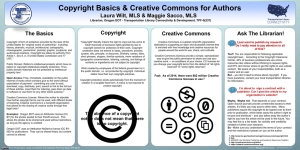
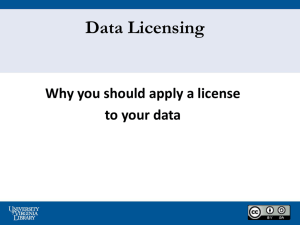
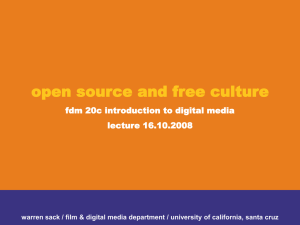
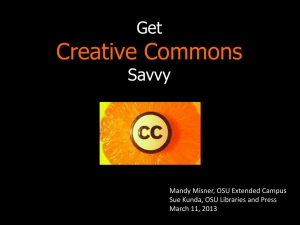
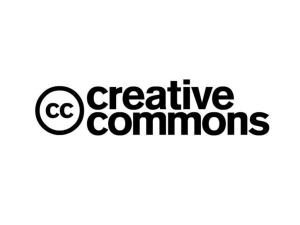
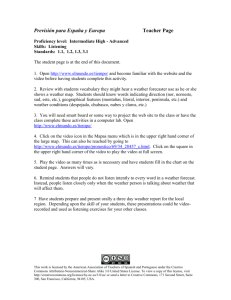

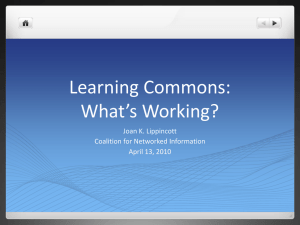
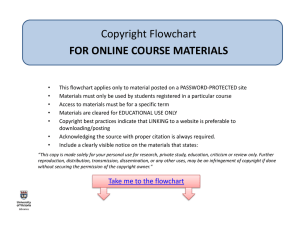
![Copyleft Presentation [English]](http://s2.studylib.net/store/data/005422621_1-22fca5bcd233f6088a57b404dac969db-300x300.png)
